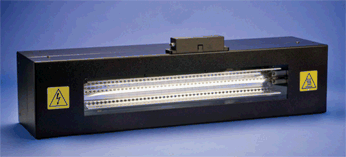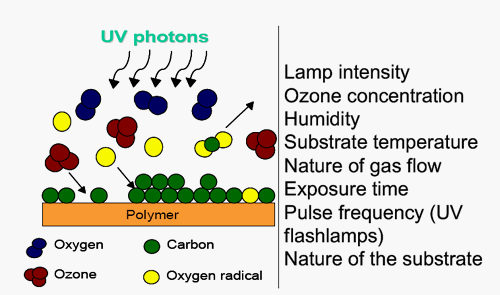펄스UV 표면 세정 / 표면개질 시스템
페이지 정보
작성자 디티엑스 작성일22-02-08 10:02 조회294회 댓글0건본문
펄스UV 표면 세정 / 표면개질 시스템 (PULSE UV SURFACE CLEANING / DEVELOPMENT SYSTEM)
Paint and adhesive performance depends on the quality (cleanliness and surface energy) of the substrate (adherent) surface. Disadvantages of existing surface pretreatment methods like plasma, flame, corona, and solvent washing are labor intensive, time consuming, damage to the adherent surface, and emission of volatile organic compounds. Many polymers used as matrices for polymer composites are being investigated. Figure 8 obtained at MSU within the past year with a wide range of thermoset and thermoplastic polymers illustrates the significant improvements in surface energy that can be obtained and that have resulted in better wetting of plastic surfaces by adhesives and coatings, and substantial increase in adhesion of UV treated surfaces as measured by a tensile butt test to an epoxy matrix. Polymers investigated have included thermoplastic as well as thermoset matrices. Although this group of polymeric matrices represents some of the materials commonly used in industry (TPO, Polypropylene, Polyester, Polycarbonate, Poly Phenylene Sulfide, Poly methylmethacrylate and vinyl ester), the breadth of applicability of this pulsed UV treated method indicates that it has a high potential of being very useful with other materials as well.
Figure 8: Samples treated with pulsed UV (Figure provided by Prof. Lawrence T. Drzal)
A model including the important parameters of this UV surface treatment and comparison of methods are shown in Figures 9 and 10 respectively. The flexibility of pulse light delivery to the substrate (i.e., pulse recurrence frequency, pulse duration, and spectrum) brings “tuning” possibilities to various substrates. Pulsed UV meets the need for a continuous, environmentally benign, fast, cost effective and non-contact surface preparation process.
Figure 9: Parameters for surface treatment process model. (Figure provided by Prof Lawrence T. Drzal)
Figure 10: Comparison of conventional surface treatment and pulsed UV. (Figure provided by Prof. Lawrence T. Drzal)
|




 Pulsed
UV can be used as a
non-contact polymer
and metal surface treatment,
as reported by Prof.
Lawrence T. Drzal, Composite
Materials & Structures
Center, Dept. of Chemical
Engineering and Materials
Science, Michigan State
University (USA).
Pulsed
UV can be used as a
non-contact polymer
and metal surface treatment,
as reported by Prof.
Lawrence T. Drzal, Composite
Materials & Structures
Center, Dept. of Chemical
Engineering and Materials
Science, Michigan State
University (USA).

